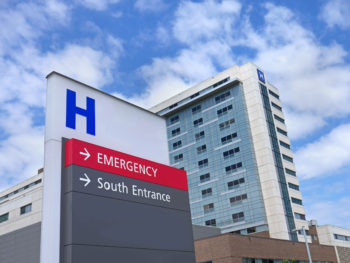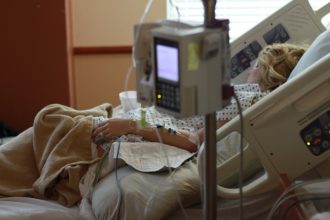By Jordan Rau and Andy Miller
Medicare has penalized 21 Georgia hospitals for having the highest rates of patient infections and potentially avoidable complications.
That’s up slightly from the 18 hospitals in the state that drew penalties in the last round of federal assessments.
For the penalized hospitals, Medicare payments are reduced by 1% for each bill from October 2021 through September 2022.
The hospitals getting penalized include large facilities in metro Atlanta, Augusta, Macon and Columbus, and some serving smaller cities.

Overall, 764 hospitals drew the punishments. Among them are more than three dozen that Medicare’s Care Compare – run by the federal Centers for Medicare and Medicaid Services (CMS) — simultaneously rates as among the best in the country, Kaiser Health News reported.
None of those with conflicting evaluations is in Georgia.
The penalties are based on the experiences of Medicare patients discharged from the hospital between July 2018 and the end of 2019, before the pandemic began. (Here’s a link to the list of hospitals penalized; plug “Georgia” into the state bar.)
On any given day, one in every 31 hospital patients has an infection contracted during their stay, according to the CDC. Infections and other complications can prolong hospital stays, complicate treatments and, in the worst instances, kill patients.
The punishments, which the 2010 Affordable Care Act requires to be assessed on the worst-performing 25% of general hospitals each year, are intended to make hospitals focus on reducing bedsores, hip fractures, blood clots, and the cohort of infections that before Covid-19 were the biggest scourges in hospitals. Those include surgical infections, urinary tract infections from catheters, and antibiotic-resistant germs like MRSA.
Eight years into the Hospital-Acquired Condition Reduction Program, 2,046 hospitals have been penalized at least once, a KHN analysis shows. But researchers have found little evidence that the penalties are getting hospitals to improve their efforts to prevent bedsores, falls, infections, and other harm to patients.
“Unfortunately, pretty much in every regard, the program has been a failure,” said Andrew Ryan, a professor of health care management at the University of Michigan’s School of Public Health, who has published extensively on the program.
“It’s very hard to capture patient safety with the surveillance methods we currently have,” he told KHN. One problem, he added, is “you’re kind of asking hospitals to call out events that are going to have them lose money, so the incentives are really messed up for hospitals to fully disclose” patient injuries. Academic medical centers say the reason nearly half of them are penalized each year is that they are more diligent than other types of hospitals in finding and reporting infections.

Another issue raised by researchers and the hospital industry is that under the law, CMS each year must punish the quarter of general care hospitals with the highest rates of patient safety issues even if they have improved and even if their infection and complication rates are only infinitesimally different from those of some non-penalized hospitals.
CMS noted in a statement that it had limited ability to alter the program. “CMS is committed to ensuring safety and quality of care for hospital patients through a variety of initiatives,” the agency said. “Much of how the Hospital-Acquired Condition (HAC) Reduction Program is structured, including penalty amounts, is determined by law.”
In developing the penalties, CMS evaluated 3,124 general acute hospitals. Exempted from the evaluation are about 2,000 hospitals. Many of those are critical access hospitals, which are the only hospitals serving a geographic — often rural — area. The law also excuses hospitals that focus on rehabilitation, long-term care, psychiatry, children’s care or veterans’ care.
The KHN analysis found that the government penalized 38 of the 404 hospitals that were both included in the hospital-acquired conditions evaluation and had received five stars for “overall quality,” which CMS calculates by using dozens of metrics. Those include not just infection and complication rates but also death rates, readmission frequency, ratings that patients give the hospital after discharge, and hospitals’ consistency in following basic protocols in a timely manner, such as giving patients medicine to break up blood clots in the 30 minutes after they display symptoms of potential heart attacks.
In addition, 138 of 814 hospitals with the next-highest rating of four stars were docked by the program, KHN found.
Lower-rated hospitals were penalized with a higher frequency: Although just 9% of five-star hospitals were punished, 67% of one-star hospitals were.

KHN’s analysis found major discrepancies between the list of penalized hospitals and how Medicare’s Care Compare rated them for virtually the same patient safety infection rates and conditions.
Nancy Foster, the vice president for quality and patient safety at the American Hospital Association, said the penalties would cause more stress to hospitals already struggling to handle the influx of Covid patients, staffing shortages, and the extra costs of personal protective equipment. “It is demoralizing to the staff when they see their hospital is deemed unsafe or less safe than other hospitals,” she said.
Dr. Karen Joynt Maddox, co-director of the Center for Health Economics and Policy at Washington University in St. Louis, said it is time for Congress and CMS to re-evaluate the penalty program.
“When this program had started, the thought was that we would get to zero” avoidable complications, she said, “and that hasn’t proven to be the case despite a really good effort on the part of some of these hospitals.”
Joynt Maddox said the hospital-acquired conditions penalty program, and other quality-improvement programs created by the ACA, feel “very ready for a refresh.”
Jordan Rau is a reporter for Kaiser Health News.

